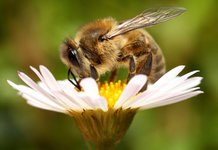
The first part of the beekeeper’s professional slang seemed to interest you, so I tried to finish writing the topic as quickly as possible.
So, let's continue ...

Bees tinder. These are bees, like the uterus, that is, also females. They differ from her only in that they are unfertilized.
In the absence of a uterus in the family and the absence of an open brood, an excess of royal jelly occurs in bees. They begin to feed them each other.
Such feeding leads to the fact that each of these bees begins to biologically feel like a uterus. She begins to lay eggs, but not like a real uterus, 1500 and 2500 per day, but only 10-20. And not one at a cell, but it happens several at once. Such a family, if the beekeeper does not intervene, is doomed to death.

Club. In winter, when bees are reduced in activity, to save heat and feed, they are compressed on the frame, forming a figure resembling a ball. Beekeepers call it "gathered in a club."
Hair curlers. In a bee family, the uterus is always alone when they are more than they kill each other. Ultimately, only the strongest survives.
However, when the beekeeper removes the queens, he lays 10 to 60 queen cells in one family. In order for the young uterus not to kill each other after the release, a plastic net is put on the mother cells, which in its appearance, somewhat resembles female curlers.
Armor. The beekeeper does not always give a mature uterus to the family. Often these are queen cells. In order to prevent the bees from gnawing the queen bee (and they always do it from the side), a special cone net is put on it, which has only one small hole at the bottom, through which the uterus can go, and it is impossible to gnaw the queen beard from the side.

Uterus in a cage. Sometimes during a honey collection, in order to reduce the amount of open brood, thereby ultimately increasing the amount of honey that the bees could feed this brood, the beekeeper encloses the uterus for a while.
The cells in this cage are of such a size that the bees can enter and feed the uterus, and the uterus itself is not able to leave it.
The family was flooded.With a very stormy bribe in nature, the bees fill the cells with fresh nectar immediately after brood emerges from them. It comes to the fact that the uterus simply has nowhere to worm. In such a family, there is a lot of honey at the end of the bribe, and few bees.

Frames are empty, like a tambourine. This expression is the opposite of the previous one when there is no bribe in nature at all.
Priva. A swarm emerging from a hive can sit on any branch he likes. Sometimes he sits very high and it is extremely difficult to remove it. In order for the swarm to sit not anywhere, but in a specific place, the beekeeper establishes a scion. This is usually one or more old frames attached to a pole.

Division by half a flight. There are many ways to propagate bee families. Among them, there is one when, next to the bee family, they put another beehive and the whole family is literally divided in half. And then the hives are pushed apart so that the flying bees that return from the field are distributed approximately equally.
The grass. During flowering, honey plants are often treated with pesticides and insecticides. Such treatments lead to the death of flying bees or families completely.
This is not a complete list of those slang words and expressions that beekeepers use in their everyday life. In my next articles, I will definitely share with you and other knowledge.


























